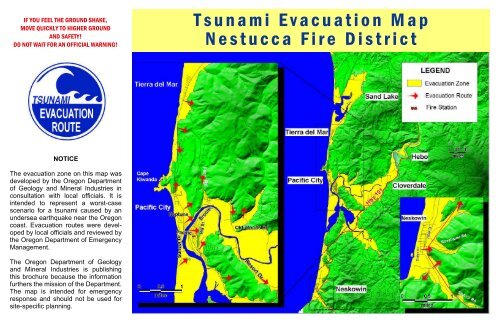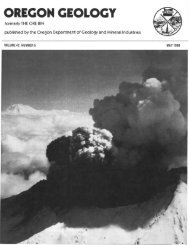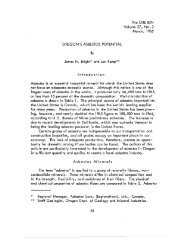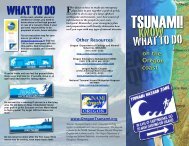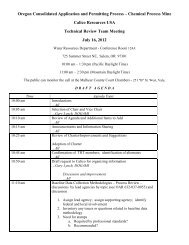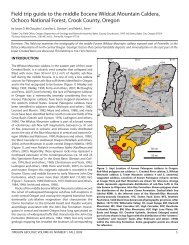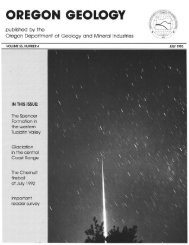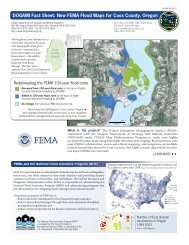Nestucca, Oregon Tsunami Evacuation Map - Oregon Department of ...
Nestucca, Oregon Tsunami Evacuation Map - Oregon Department of ...
Nestucca, Oregon Tsunami Evacuation Map - Oregon Department of ...
You also want an ePaper? Increase the reach of your titles
YUMPU automatically turns print PDFs into web optimized ePapers that Google loves.
IF YOU FEEL THE GROUND SHAKE,<br />
MOVE QUICKLY TO HIGHER GROUND<br />
AND SAFETY!<br />
DO NOT WAIT FOR AN OFFICIAL WARNING!<br />
T s u n a m i E v a c u a t i o n M a p<br />
N e s t u c c a F i r e D i s t r i c t<br />
NOTICE<br />
The evacuation zone on this map was<br />
developed by the <strong>Oregon</strong> <strong>Department</strong><br />
<strong>of</strong> Geology and Mineral Industries in<br />
consultation with local <strong>of</strong>ficials. It is<br />
intended to represent a worst-case<br />
scenario for a tsunami caused by an<br />
undersea earthquake near the <strong>Oregon</strong><br />
coast. <strong>Evacuation</strong> routes were developed<br />
by local <strong>of</strong>ficials and reviewed by<br />
the <strong>Oregon</strong> <strong>Department</strong> <strong>of</strong> Emergency<br />
Management.<br />
The <strong>Oregon</strong> <strong>Department</strong> <strong>of</strong> Geology<br />
and Mineral Industries is publishing<br />
this brochure because the information<br />
furthers the mission <strong>of</strong> the <strong>Department</strong>.<br />
The map is intended for emergency<br />
response and should not be used for<br />
site-specific planning.
CONTACTS<br />
<strong>Oregon</strong> Emergency Management<br />
3225 State Street, P.O. Box 14370<br />
Salem, OR 97309<br />
(503) 378-2911<br />
http://egov.oregon.gov/OOHS/OEM/<br />
Tillamook County Emergency Services<br />
5995 Long Prairie Rd.<br />
Tillamook, OR 97141<br />
(503)842-3412<br />
http://www.co.tillamook.or.us/<br />
<strong>Nestucca</strong> Rural Fire Protection District<br />
34325 Highway 101 S.<br />
Cloverdale, OR 97112<br />
(503) 392-3313<br />
<strong>Oregon</strong> <strong>Department</strong> <strong>of</strong> Geology and Mineral Industries<br />
800 NE <strong>Oregon</strong> Street #28, Suite 965<br />
Portland, OR 97232<br />
(971) 673-1555<br />
http://www.oregongeology.com<br />
Nature <strong>of</strong> the Northwest Information Center<br />
800 NE <strong>Oregon</strong> Street #5, Suite 177<br />
Portland, OR 97232<br />
(503) 872-2750<br />
http://www.naturenw.org/<br />
International <strong>Tsunami</strong> Information Centre<br />
Box 50027<br />
Honolulu, HI 96850-4993<br />
(808) 541-1658<br />
http://www.tsunamiwave.info/<br />
NATIONAL OCEANIC AND ATMOSPHERIC ADMINISTRATION<br />
U.S. DEPARTMENT OF<br />
RECOVERY<br />
RESPONSE<br />
COMMERCE<br />
PREPAREDNESS<br />
MITIGATION<br />
Funded by the National Oceanic and Atmospheric Administration<br />
under SO #OBLIG-2000-5332-0-0 through the <strong>Oregon</strong> <strong>Department</strong> <strong>of</strong><br />
Geology and Mineral Industries. Published by the <strong>Oregon</strong> <strong>Department</strong><br />
<strong>of</strong> Geology and Mineral Industries with assistance by Shoreland<br />
Solutions, Newport, <strong>Oregon</strong>, and in cooperation with <strong>Oregon</strong><br />
Emergency Management and Tillamook County.<br />
O R E G O N<br />
D E PA R T M E N T<br />
O F<br />
DOGAMI-TS-EB-NES-01 (11/05)<br />
G E O L O G Y<br />
1937<br />
A N D<br />
M I N E R A L<br />
oREGON<br />
emergency management<br />
I N DU S T R I E S<br />
TSUNAMI<br />
E V ACUAT ION M A P<br />
N est u c c a F i r e D i str i c t<br />
I F Y O U F E E L A N EAR T HQUAK E :<br />
• PROTECT YOURSELF UNTIL THE<br />
EARTHQUAKE IS OVER<br />
• MOVE QUICKLY INLAND TO HIGH GROUND<br />
AND AWAY FROM LOW-LYING COASTAL AREAS<br />
— GO ON FOOT IF AT ALL POSSIBLE—<br />
• DO NOT WAIT FOR AN OFFICIAL WARNING<br />
• DO NOT PACK OR DELAY<br />
• DO NOT RETURN TO SHORE<br />
• WAIT FOR AN “ALL CLEAR" FROM LOCAL<br />
OFFICIALS BEFORE RETURNING TO LOW-<br />
LYING AREAS<br />
A TSUNAMI MAY BE COMING IN<br />
A FEW MINUTES. MORE WAVES<br />
MAY BE COMING FOR SEVERAL<br />
HOURS AFTER THE FIRST.<br />
Tsuna m i E v a c uat i o n <strong>Map</strong> :<br />
N e s t u cca F i r e D i str i c t<br />
T H E INF O R M A T ION I N T HIS B R OCHUR E M A Y SAV E Y OUR L I F E .<br />
P L EASE T A K E T H E T I M E T O R EAD I T AND SHAR E WHAT Y O U HAV E<br />
L EAR NED W I T H Y OUR F A M I L Y AND F R IENDS .<br />
A tsunami is a series <strong>of</strong> sea waves usually caused by a displacement <strong>of</strong> the ocean floor by an undersea earthquake.<br />
As tsunamis enter shallow water near land, they increase in height and can cause great loss <strong>of</strong> life and property damage.<br />
People on open beaches, in low-lying areas, by bay mouths or bay tidal flats, and near mouths <strong>of</strong> rivers draining into<br />
the ocean are in greatest danger. If you find yourself in any <strong>of</strong> these areas and you feel an earthquake, you are advised<br />
to evacuate inland to higher ground. <strong>Evacuation</strong> routes and safe areas are depicted on this map. Evacuate on foot if at all<br />
possible.<br />
Recent research suggests that tsunamis have struck the <strong>Oregon</strong> coast on a regular basis. <strong>Tsunami</strong>s can occur any<br />
time <strong>of</strong> day or night. Typical wave heights from tsunamis occurring in the Pacific over the last 80 years have been<br />
between 20 to 45 feet at the shoreline. A few waves however have been much higher—as much as 100 feet or more<br />
because <strong>of</strong> local conditions.<br />
A distinction can be made between a tsunami caused by an undersea earthquake “near” the <strong>Oregon</strong> coast and an<br />
undersea earthquake “far” from the coast. For an earthquake near the coast, experts believe that a tsunami could come<br />
onshore within 15 to 20 minutes after the earthquake—before there is time for <strong>of</strong>ficial warning. The ground-shaking <strong>of</strong><br />
the earthquake may be the only warning you have!<br />
A tsunami caused by an undersea earthquake far from the <strong>Oregon</strong> coast will take several hours to come onshore.<br />
You will feel no earthquake. There will typically be time for an <strong>of</strong>ficial warning and evacuation to safety. In isolated areas<br />
along beaches and bays you may not hear a warning. Here, a sudden change in sea level should prompt you to move<br />
immediately inland to high ground.<br />
In either tsunami case, evacuate on foot if at all possible because <strong>of</strong> potential traffic jams, as well as earthquakeinduced<br />
damage to or blockage <strong>of</strong> roads.<br />
Remember: A tsunami is a series <strong>of</strong> waves. Waves may continue to arrive over several hours. Stay away from potentially<br />
hazardous areas until you receive an “all clear” from local <strong>of</strong>ficials.<br />
Aside from the<br />
devastation a tsunami<br />
leaves behind<br />
where it hits<br />
inhabited shores,<br />
it brings lots <strong>of</strong><br />
sand. This cut in<br />
the bank <strong>of</strong> the<br />
Salmon River,<br />
north <strong>of</strong> Lincoln<br />
City, <strong>Oregon</strong>, documents<br />
the tsunami<br />
associated<br />
with the great<br />
earthquake <strong>of</strong><br />
A.D. 1700.<br />
Photo from U.S.<br />
Geological Survey<br />
Circular 1187.


